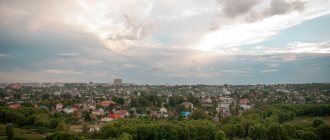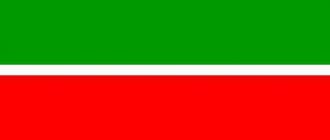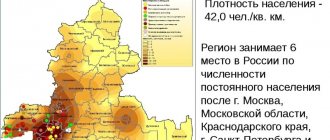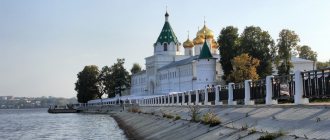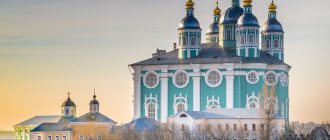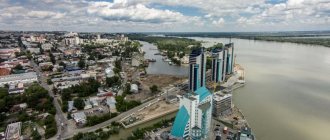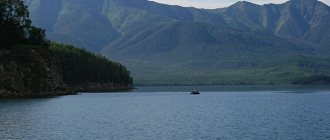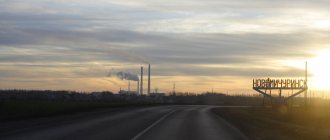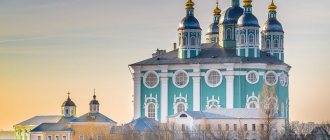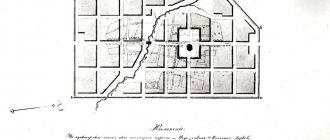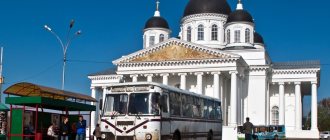Mass media
News agencies of the republic: KomiInform, BNK, KomiOnline.
Leading republican printed publications: socio-political newspapers “Respublika” (in Russian), “Tribuna” (in Russian), “Komi mu” (“Land of Komi”; in Komi language), business magazine “Region” (in Russian language); regional newspapers “Zarya” (Troitsko-Pechora district; in Russian), “Krasnaya Pechora” (Ust-Tsilemsky district; in Russian), “Znamya Truda” (Priluzsky district; in Russian), “Zvezda” (Kortkeros district ; in the Komi and Russian languages), etc.; city newspapers - “Panorama of the Capital” (Syktyvkar; in Russian), “My Vorkuta - Our Newspaper” (in Russian), “Pechora Time” (Pechora; in Russian), “Ukhta” (in Russian language) etc.
General information about the Komi Republic
Distinctive features. Moving from the central regions of Russia further to the east, we find ourselves in the “forest wilderness” - huge, simply immense spaces covered with dense forests, with many swamps and lakes.
The Komi Republic is one of the striking examples of such regions. In area it is only slightly inferior to the largest in the European part of the Russian Federation, the Arkhangelsk region. In ancient times, the vast lands of the Komi Republic were part of the Novgorod Republic, and then - part of the Moscow Principality. The main local product for a long time was fur, which was highly valued both in Rus' and Western Europe.
The harsh climate, vast territory and impenetrable forests were the main reasons for the low population of these lands. The indigenous population - the Komi - belong to the Finno-Ugric group of peoples. They can be called the first Russian oil workers - even in ancient times, tribes in the area of the Ukhta River collected oil and used it as oils and lubricants.
The Komi lands became the first region in Russia where oil production was established. Oil deposits in the Ukhta region were known back in the 15th century, but the first oil arrived in Moscow only in 1597, and the first oil “plant” was built in 1745.
Black gold - the wealth of the Komi Republic
This is how minerals, especially oil and gas, became the basis of the economy of the Komi Republic. Another local wealth is timber, the extraction and processing of which also plays an important role in the local economy.
Forests cover 70% of the territory of the Republic, another 15% are swamps. The virgin forests of the Northern Urals are the only ones in Europe that have remained untouched by human intervention. Therefore, the Pechora-Ilychsky biosphere reserve was included in the list of UNESCO World Heritage Sites.
Geographical location . The Komi Republic is located in the European part of the Russian Federation, west of the Ural Mountains, separating Europe and Asia. It is part of the Northwestern Federal District. The neighbors of the Republic are in the south - the Kirov region, the Sverdlovsk region and the Perm Territory, in the north and west - the Arkhangelsk region with the Nenets Autonomous Okrug, in the east - the Yamalo-Nenets Autonomous Okrug and the Khanty-Mansiysk Autonomous Okrug.
The northern regions, including Vorkuta, belong to the regions of the Far North. Most of the regions of the Republic belong to territories equated to regions of the Far North.
Due to its vast territory, the nature of the Komi Republic is extremely diverse. There is both cold tundra and vast taiga forests, mixed forests in the south, and the high-altitude zone of the Ural Mountains in the east.
Yugyd Va National Park (“Bright Water”)
The main rivers are Izhma, Mezen, Pechora, Sysola, Vychegda. Once upon a time they played an important role as trade routes for Novgorod merchants, who traveled with the help of oars and portages to distant Siberia.
Of the 78,000 lakes located here, there are many beautiful ones, including mountain ones.
Population. The Komi Republic has a population of 880,639 people. At the same time, the population density is only 2.11 people. per sq. km. 77% of the Republic's residents are urban. After the collapse of the USSR, the region's economy experienced difficult times. Many preferred to leave for more favorable areas of Russia. Thus, the population of the Republic has decreased by more than 20% in less than 20 years.
Komi can truly be called a national autonomy, although the majority of the population is Russian (61.69%). The indigenous population - the Komi - make up 22.45% of the inhabitants, which is not so small when compared with other autonomies. The Komi Republic is inhabited primarily by Komi-Zyryans, while the southern group of people, the Komi-Permyaks, settled in the neighboring Perm region.
Komi-Zyryans in national costumes
Crime . 25th place in the ranking in terms of the number of crimes committed - an average figure for the regions of the Russian North. But this doesn’t make things any easier for residents. Murders, robberies and fights occur here regularly.
The unemployment rate in the Komi Republic is 6.4%. There is no such developed industry here as in the central regions, and the oil and gas industry alone is not able to provide work to the small population. In 2012, the average salary in the Republic was 33 thousand rubles. And the highest earnings are in industries such as the extraction of fuel and energy minerals, oil refining, and chemical production.
The cost of real estate in the Komi Republic is quite high. One-room apartments for 2 million rubles are by no means uncommon here. Two-room apartments, accordingly, are even higher, from 2.7-2.8 million rubles. But what can you do - the region of oil workers dictates prices in accordance with demand, and thanks to local salaries, it is quite high.
The climate is temperate continental. The winter here is quite cold with an average January temperature of −17… −20°C. In rare cases, in winter the temperature reaches −50°C. Summer is short and cold, with an average temperature in the warmest month (July) +11...+17°C. This spread is due to the large extent of the territory from north to south, and of course, in the southern part the weather is warmer. But even there the climate is quite harsh. The average annual precipitation is 700 mm.
Settlement by region
Syktyvkar is the capital and most populated city of the Komi Republic. Its population density is 1609 people/sq. km. 244 thousand people live in Syktyvkar. Ukhta is the second largest city in the Komi Republic. Its population density is even higher – 7,500 people/sq. km. Almost one hundred thousand people live in the city. The third most populated city is Vorkuta. It has 58 thousand inhabitants. Another 40 thousand people live in Pechora and Isinka. The smallest city is Ust-Kulom. It has only 5,000 inhabitants.
Read also: Why and who needs reviews
As for the indigenous population of the cities of the Komi Republic, it should be noted that in Syktyvkar there are almost 26 percent of Zyryans, and in Vorkuta, for example, only 1.7. There are many Komi residents in the cities of Inta (11 percent), Pechora (13.2%), and Vuktyl (10.8%). Most of the indigenous people live in the Izhemsky district - 88.9 percent of them there. The highest population density is in the capital of the Republic and its surroundings. The least number is in the north of the region.
Cities of the Komi Republic
The Komi Republic is an unusual and very interesting region, home to 865 thousand citizens. The Komi Republic was also loved by the Vikings, who visited this region for fur. The populated areas of the Republic are small. They are surrounded on all sides by beautiful pristine nature. There are 23 settlements in Komi, 10 of which are small towns. It is their description that we will devote this material to.
| № | Population (persons) |
| 1. | Syktyvkar 244 646 |
| 2. | Ukhta 97 806 |
| 3. | Vorkuta 58 133 |
| 4. | Pechora 40 048 |
| 5. | Usinsk 38 800 |
| 6. | Sosnogorsk 26 571 |
| 7. | Inta 26 271 |
| 8. | Emva 12 906 |
| 9. | Vuktyl 10 205 |
| 10. | Mikun 9 837 |
| Total: | 565223 |
Syktyvkar
This city is the administrative center of the Republic. Syktyvkar is a center of commuting labor migration, so citizens from suburban areas come here every day to work. 242.7 thousand people live in Syktyvkar. This is the oldest city, whose history began in the 16th century. The economy of Syktyvkar is supported by industrial and energy-related enterprises. This city has many attractions. Guests are greeted here by delightful sculpture monuments, as well as golden-domed temples and cathedrals. There are few new houses in Syktyvkar, mostly Stalinist buildings predominate, but this does not prevent the city from maintaining its bright national flavor.
Ukhta
This settlement, where 98.9 thousand people live safely, has an amazing history. This city is famous for the fact that it was here that the first Russian oil was extracted from the depths of the earth. Today Ukhta is distinguished by its good economic development: there are many hospitals, schools, universities and technical schools. Also in Ukhta there is a local history museum, churches, nature reserves, and monuments. This city has two main economic directions - the gas industry and oil production.
Vorkuta
This city, which is located in the northern part of the Komi Republic, has an inhospitable climate. But this is not surprising, because it is located in the permafrost zone. Today there are 58,133 people living in Vorkuta. The settlement was founded in the 30s of the XX century. There are many buildings in Vorkuta. These are Soviet-built schools, old houses, museum and exhibition centers. The climate of Vorkuta is unusual - there are few cold days here in the summer. On long cold winter nights here you can enjoy the beauty of such a miracle as the Northern Lights.
Pechora
The city of Pechora is located in the northeastern zone of Komi. It is also called the mighty “energy capital”, since it is in this locality that the Pechora State District Power Plant operates. A little more than 40,000 people live in Pechora. There are few places of interest here, but they exist. This is the Bogoroditsky Monastery and unusual sculptural monuments of the city. Previously, this settlement attracted industrialists. People even came here from Kronstadt for logging work. Exiled citizens, who numbered more than 300 here in 1905, made a great contribution to the development of the city. Today Pechora is the center of the forestry and woodworking industries, but there are also enterprises in the electric power complex and the oil industry in the city.
Usinsk
This settlement has been a village for a long time. Usinsk received city status only in 1984. It is considered the youngest district of the republic. Today, 39.4 thousand people live in Usinsk. Despite the inhospitable harsh climate, this city is proud of its oil fields. Today, Usinsk oil is a key source of replenishment of not only regional, but also republican budgets. There are currently about 1,000 organizations operating in the city, employing about 25,000 citizens. There are 26 educational institutions and 17 kindergartens in Usinsk.
Inta
Inta is a small town in Komi. More than 30,000 people live here. The history of this tiny town is connected with coal. It was the mining of coal deposits that caused the first houses to appear in Inta. Today the city has entered a stage of economic decline. The Intinskaya mine, which is the main employment center, employs only one and a half thousand workers. This town is built up with wooden houses and nondescript buildings. The only attraction of this settlement is the majestic brick water tower. It was built back in 1955 by an architect from Sweden. Now the tower building houses a museum.
Sosnogorsk
This settlement appeared in 1955. The city covers an area of 25 thousand square meters. Sosnogorsk is located on the banks of the Izhma River. Today about 30,000 people live in Sosnogorsk. The locality is proud of an art gymnasium, a family-type orphanage, a garment factory, churches, gas processing plants, and woodworking enterprises. There are also museums and sports complexes here. The main economic direction of Sosnogorsk is the oil industry.
Emva
This settlement appeared in the 1930s. For a long time this village was called Zheleznodorozhny. It became the city of Yemva in 1985. For a certain period of time, 85,000 prisoners stayed here, who helped the city’s economy reach certain heights. Today Yemva is going through hard times. The city's economy is boosted by only two enterprises - a fiberboard manufacturing plant, as well as the Knyazhpogost mechanical plant. The House of Culture is located in the center of Yemva.
Vuktyl
This settlement appeared in Komi when a person discovered a gas condensate field on the banks of the Pechora. The village of Vuktyl was first formed around this deposit. When the mining site was well developed, the village was classified as a city. Today in the city of Vuktyl there are 23 industrial enterprises and about 200 trade enterprises. There are hospitals and six paramedic and obstetric centers in the city. The main attraction of Vuktyl is the Church of the Annunciation of the Blessed Virgin Mary.
Mikun
The fate of this settlement is very closely connected with the construction of the North Pechora Railway. At first Mikun was a workers' village. In 1959, this small settlement received the long-awaited status of a city. Today only 10,000 people live here. Mikun's economy is supported by railway transport enterprises, as well as a compressor station. There are few noteworthy objects here - this is the Historical Museum of the Northern Railway, as well as the House of Culture.
Population of the Komi Republic
From time immemorial, the region was sparsely populated, but during Soviet times the number of inhabitants began to grow rapidly. According to Rosstat, at the beginning of 2022, 840,788 people make up the population of Komi. The republic has an area of 416,774 square kilometers. Of these, 7.7% are swamps and 1.5% are water, that is, non-residential surface. Thus, the average population density of the Komi Republic is 2.02 people per square meter. km. For comparison: the region ranks 13th in the country in terms of area. However, in terms of the number of inhabitants, Komi is only in 16th place. There is only one city in the Republic with a population of more than one hundred thousand people.
see also
- Komi Republic
- Cities of Russia
| [ + ] Cities by regions of Russia | |
| Cities of the North-West (NWFD) | St. Petersburg (and its cities) • Leningrad region (historical Staraya Ladoga) • Arkhangelsk region • Vologda region • Kaliningrad region • Karelia • Komi • Murmansk region • Nenets Autonomous Okrug • Pskov region |
| Cities of the Volga region (Volga Federal District) | Bashkortostan • Volgograd region • Kalmykia • Kirov region • Mari El • Mordovia • Nizhny Novgorod region • Orenburg region • Penza region • Perm region • Samara region • Saratov region • Tatarstan • Udmurtia • Ulyanovsk region • Chuvashia |
| Cities of Southern Russia (SFD) | Sevastopol (including Inkerman) • Republic of Crimea • Adygea • Astrakhan region • Krasnodar region • Rostov region |
| Cities of the North Caucasus (NCFD) | Dagestan • Ingushetia • Kabardino-Balkaria • Karachay-Cherkessia • North Ossetia - Alania • Stavropol Territory • Chechen Republic |
| Cities of the Urals (Ural Federal District) | Kurgan region • Sverdlovsk region • Tyumen region • Khanty-Mansi Autonomous Okrug - Yugra • Chelyabinsk region • Yamalo-Nenets Autonomous Okrug |
| Cities of Siberia (Siberian Federal District) | Altai Republic • Altai Territory • Irkutsk Region • Kemerovo Region • Krasnoyarsk Region • Novgorod Region • Novosibirsk Region • Omsk Region • Tomsk Region • Tyva • Khakassia |
| Cities of the Far East (FEFD) | Amur Region • Buryatia • Jewish Autonomous Region • Trans-Baikal Territory • Kamchatka Territory • Magadan Region • Primorsky Territory • Sakha (Yakutia) • Sakhalin Region • Khabarovsk Territory • Chukotka Autonomous Region |
| see also | Cities of the DPR, LPR, Transnistria, South Ossetia • Regions of Russia • Cities of Russia |
Theater
Scene from the play “Wedding with a Dowry” by N. M. Dyakonov. Drama Theater. Syktyvkar.
During the years of Civil war of 1917–22 in Ust-Sysolsk V. A. Savin founded the troupe, which soon received the name. "Sykomtevchuk" (Ust-Sysolsk Komi Theater Association). In 1930, Savin organized theater courses, whose graduates formed the core of the KIPPT theater (Komi Instructional Mobile Demonstration Theater). In the same year, Rus opened in Syktyvkar. dramatic theater under control A. S. Khodyreva. In 1936, both groups united within the framework of Dramatic. theater (since 1978 named after V. A. Savin, since 1995 academic, since 1996 Drama Theater). The republic also operates: Dramatich. theater (1943, until 1952 musical and dramatic), puppet theater (1955) - in Vorkuta. Nar. theaters operate in Syktyvkar, Vorkuta, Inta, Ukhta, Pechora, in the regional centers and villages of Aikino, Vylgort, Kortkeros, Obyachevo, Pomozdino, Ust-Kulom. In 1989, the Literary and Theater Museum named after. N. M. Dyakonova. Means. Contributions to the development of theatrical art in Kazakhstan were made by: I. I. Avramov, M. E. Danilov, S. I. Ermolin, I. N. Krivoshein, V. D. Lekanov, P. A. Mysov, L. F. Oborina, A. S. Rusina, G. P. Sidorova, N. N. Turubanov, S. I. Fetisova, G. I. Shcherbakov and others.
